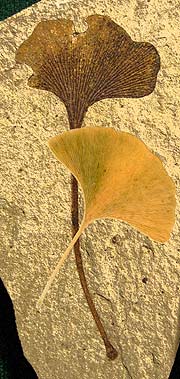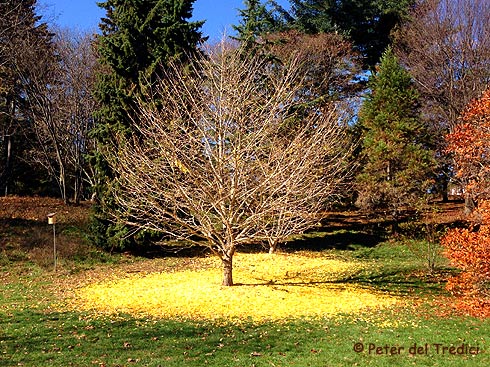|
 Cor
Kwant Cor
Kwant |
 News+ News+ |
|
|
|
|
|
![]() Last
updates:
Last
updates:![]()
![]()
*
Update
Awards-page with El País
- el periódico global en Español:
July 2022 Article "El ginkgo, el árbol que sobrevivió a los
dinosaurios y a la bomba atómica" with mentioning of this website
The Ginkgo Pages.
*
Update
Literature-and
Awards-pages
with
article by International Biological Flora: Ginkgo biloba (with references
to this website The Ginkgo Pages).
*
New photo on Photospecial page: These Ginkgo
leaves do not turn yellow but contrasting green on the edges, very special.
| MORE
UPDATES OF MY PAGES:
* New photo on Photospecial page: Ginkgo bark and leaves. * New photo on Photospecial page: Sprouting Ginkgo leaves in my garden. * Update Tree-page with article by Li Wang et al.: Culture - Ginkgo almost immortal + article added to Literature-page. * New topic: Ginkgo tree almost immortal study reveals. * New photo on Photospecial page: Ginkgo "Heksenbezem Leiden" in my garden. * Update Fossils-page , History-page and Tree-page with article by Zhao et al.: Ancient refugium in East China + article added to Literature-page . * Added special Ginkgo stamps page. * Updated contents of my blog. * New photo on Photospecial page: Ginkgo pollen on male tree in spring. * New photo on Photospecial page: Ginkgo leaf and raindrops. * New topic: Long-term stable refugia for relict plant species in East Asia. * New photo on Photospecial page: Ginkgo reflections, Hortus botanicus Leiden. * New topic: Gymnosperms on the Edge. * New photo on Photospecial page: My Ginkgo seedling. * Added photo of guitar made of Ginkgo wood on Wood-page. * Added Hugo Boss on Art-page: fashion. * New photo on Photospecial page: Huge Ginkgo tree in fall, c. 1856, Anduze in France. * Added photos of Aachen (Germany) + Tongeren and Maaseik (Belgium) on Where-page. * New topic: Ginkgo trees on New York City Street Map. * New photo on Photospecial page: female Ginkgo tree with seedlings, medieval Chateau de Bourdeilles, France. * New photo on Photospecial page: Raindrops on Ginkgo leaf. * Added many stamps on my Art-page. * Added 2 new photos on picture gallery Art-page: Dijsselhof - Kunst en Samenleving * New photo on Photospecial page: Pollen on male Ginkgo tree. * New topic: Cretaceous fossil relative of Ginkgo discovered. * Updated Fossils-page: Ginkgo Jurassic wood. * Updated Literature-page: 2 new articles: 1. Ginkgo genome sequence and 2. Ginkgo Jurassic wood. * New topic: Jurassic wood provides insights into Ginkgo wood evolution. * New topic: Complete genome sequence of Ginkgo decoded. * New photo on Photospecial page: Fallen Ginkgo leaves + poem by Howard Nemerov. * Update new topic: 2nd generation A-bombed Ginkgo tree planted at UN Geneva, Oct. 3. * New photo on Photospecial page: Old Ginkgo tree, Maldegem, Belgium + video. * New photo on Photospecial page: Many Ginkgo trees in Zwolle, Cemetery Kranenburg. * New photo on Photospecial page: Ginkgo leaf. * New topic: 2nd generation A-bombed Ginkgo tree to be planted by UNITAR. * New photo on Photospecial page: My Ginkgo seedling 1 week old. * Added microphoto of Ginkgo stem cross section on my Wood-page. * New photo on Photospecial page: Sprouting Ginkgo leaves in spring. * Added to Art-page: Text and pictures first Western documentation of Ginkgo in China. * Added on Nancy-page: photos of Ginkgo leaves on door to The Ecole de Nancy Museum, Nancy Art Nouveau by Jacques Gruber. * New topic: The Ginkgo Tweets: 2500+ followers on Twitter! * New photo on Photospecial page: Fallen Ginkgo leaves. * New topic: The Ginkgo Pages Forum/Blog in 2015. * New topic: My website and blog are archived in the National Library of the Netherlands Web Archive (Webarchief van Nederland Koninklijke Bibliotheek) for present and future generations. * New photo on Photospecial page: potted Ginkgo in fall colours. * Added photos of Ginkgo trees 5th Avenue NYC, Washington Square Park and Philadelphia on Where-page and Empire State building and Ginkgo tree. * Added on Propagation-page: video of deer eating Ginkgo seeds in Japan. * Added spherical panorama photo of Hiroshima Ginkgo at Hosen-Ji. * Added Art-page Picture gallery: work by Tom Phillips A Humument Page 297 + Portrait of Iris Murdoch. * New Photo on Photospecial page: Ginkgo trees in Bologna, Italy. *Added new Ginkgo bonsai photo. * Added new theory about the spelling of Ginkgo: on my Name-page. * Added on Literature-page and Dalou-page: book The Subtropical Vegetation of Southwestern China by Cindy Q. Tang (contains chapter Dalou Mountains). * New topic: The Ginkgo Tweets: 2000+ followers on Twitter! * New supersized photos on my Photospecial page: Ginkgo huttonii fossil leaves. * New supersized photo on my Photospecial page: Spring: my seedlings are alive! * New supersized photo on my Photospecial page: Snow covered Ginkgo tree. * Added: Asteroid Ginkgo to Name-page. * New topic: Asteroid Ginkgo. * New supersized photo + video on my Photospecial page: 4 Ginkgo trees, planted c. 1882, Strasbourg in France. * Added new photo of female tree: leaves fall before the seeds. * New topic: Contributions by Peter del Tredici, Harvard University. * New topic: Story about the Ginkgo at Hellekis manor, Kinnekulle, Sweden. * Added special page on Bonsai-page with dwarf (penjing) Ginkgo trees from China, photos by James Wilkins. * New topic: Oliver Sacks: Night of the Ginkgo (The New Yorker). I
don't mention minor updates here. Not all changes are updated on the German/French/Dutch
summaries.
Ginkgo
tree almost immortal study reveals
From
the article:
Article:Li
Wang et al. Multifeature analysis of vascular cambium cells reveal longevity
mechanisms in old Ginkgo biloba trees. PNAS, January 2020.
Long-term
stable refugia for relict plant species in East Asia
Researchers predict species chances of persistence given the future climatic changes expected for East Asia. By 2070, potentially suitable areas with high richness of relict species will decrease, although the areas as a whole will probably expand. Highest priority for conservation should be given to the long-term stable refugia. These stable climate refugia are also long-term stores of genetic diversity. The most urgent need for new nature reserves is located in the mountains of the Sichuan Basin and in southeastern, eastern and northern Yunnan, as well as the northernmost provinces and the Hoang Lien Son mountain range of Vietnam. Read
more: Cindy
Q. Tang et al. Identifying long-term stable refugia for relict plant
species in East Asia, Nature Communications| (2018) 9:4488.
More info on my website: History-page
+
Gymnosperms
on the Edge
Even without considering its extinction risk, the unique evolutionary history of Ginkgo, and the fact that it is the sole living representative of a once highly diverse group of species, make its conservation a top priority. Read more: Gymnosperms on the Edge, Article in Nature by Forest et al., 16 April 2018.
Cretaceous fossil relative of Ginkgo discovered  An
international team of paleontologists have discovered a new extinct
species of plant from the Early Cretaceous that appears to be distantly
related to living Ginkgo biloba. The fossils, named Umaltolepis
mongoliensis, were collected from ancient peat deposits at the Tevshiin
Govi lignite mine in the steppes of central Mongolia. An
international team of paleontologists have discovered a new extinct
species of plant from the Early Cretaceous that appears to be distantly
related to living Ginkgo biloba. The fossils, named Umaltolepis
mongoliensis, were collected from ancient peat deposits at the Tevshiin
Govi lignite mine in the steppes of central Mongolia.
Results of the research, supported by the National Science Foundation (NSF), are published in this week’s issue of the journal Proceedings of the National Academy of Sciences (PNAS). "The
stems and leaves are similar to the Ginkgo tree, but the seeds, and especially
the structures they are born in, are unlike any other known plant, living
or extinct," says scientist Patrick Herendeen of the Chicago Botanic Garden,
co-author of the PNAS paper.
Ginkgo may be the last survivor of a once highly diverse group of extinct plants, several of which show various degrees of ovule enclosure.
Read
more:
More info about Ginkgo fossils on my website: Fossils-page. Pictures: Chicago Botanic Garden
Complete genome sequence of Ginkgo decoded  Chinese
researchers (BGI, Zheijiang University and the Chinese Academy of Sciences)
laid bare the complete genome sequence of Ginkgo biloba, the oldest extant
tree species. Chinese
researchers (BGI, Zheijiang University and the Chinese Academy of Sciences)
laid bare the complete genome sequence of Ginkgo biloba, the oldest extant
tree species.
They reveal its genome to be huge, comprising some 10.6 billion DNA "letters", containing 41,840 annotated genes. The human genome contains just three billion letters. Multiple seeds at visually different developmental stages were collected from five separate large Ginkgo trees at one of the Ginkgo refuge populations located on Tianmu Mountain, Zhejiang Province, China. Its
genome will be an extensive resource for studies concerning plant defences
against insects and pathogens, and research investigating early events
in tree evolution and in evolution overall.
Read
more:
Photo
credit: Fossil is from Klondike Mountain Formation, Republic, Ferry County,
Washington, USA, Eocene, Ypresian. Stonerose Interpretive Center Collection,
Modern leaf photo is by Ninjatacoshell, CC BY-SA via Wikimedia Commons.
The Ginkgo Pages Forum-Blog in 2015 Do you know I maintain a blog/forum about the Ginkgo since 2005?
Transplanting 750-year-old Yonggyeri Ginkgo in South Korea Spectacular video on YouTube by Daeji Development Co., Ltd, Seoul of the transplanting of a 750-year-old Ginkgo tree, Kyungbuk Ahndonggun Yonggyeri, South Korea. This Ginkgo tree is 31 m in height, girth 14 m and is one of the biggest of South Korea, National monument no.175. The transplant is listed in the Guinness World Records register in 2013.
Contributions by Peter del Tredici, Harvard University 
Senior Research Scientist Emeritus Peter Del Tredici of the Arnold Arboretum of Harvard University, also Associate Professor in Practice, Department of Landscape Architecture, Harvard Graduate School of Design, sent me a wonderful photo to show on my website: Ginkgo tree at the Arnold Arboretum taken on November 15, 2014. He also pointed me to a short article he wrote about the popular Icho Namiki, the Ginkgo lined avenue in Meiji Jingu Gaien Park in Japan. Read his pdf here. Thank
you Peter!
Watch
videos of this avenue on YouTube:
Oliver Sacks: Night of the Ginkgo  "Night
of the Ginkgo" by Oliver
Sacks in The New Yorker: "Night
of the Ginkgo" by Oliver
Sacks in The New Yorker:
"Today in New York—November 13th—leaves are falling, drifting, skittering everywhere. But there is one striking exception: the fan-shaped leaves of the ginkgo are still firmly attached to their branches, even though many of them have turned a luminous gold. One sees why this beautiful tree has been revered since ancient times...........Will it be November 20th, 25th, 30th? Whenever it is, each tree will have its own Night of the Ginkgo. Few people will see this—most of us will be asleep—but in the morning the ground beneath the ginkgo will be carpeted with thousands of heavy, golden, fan-shaped leaves." Read full piece in The New Yorker of November 24, 2014.
© Cor
Kwant |